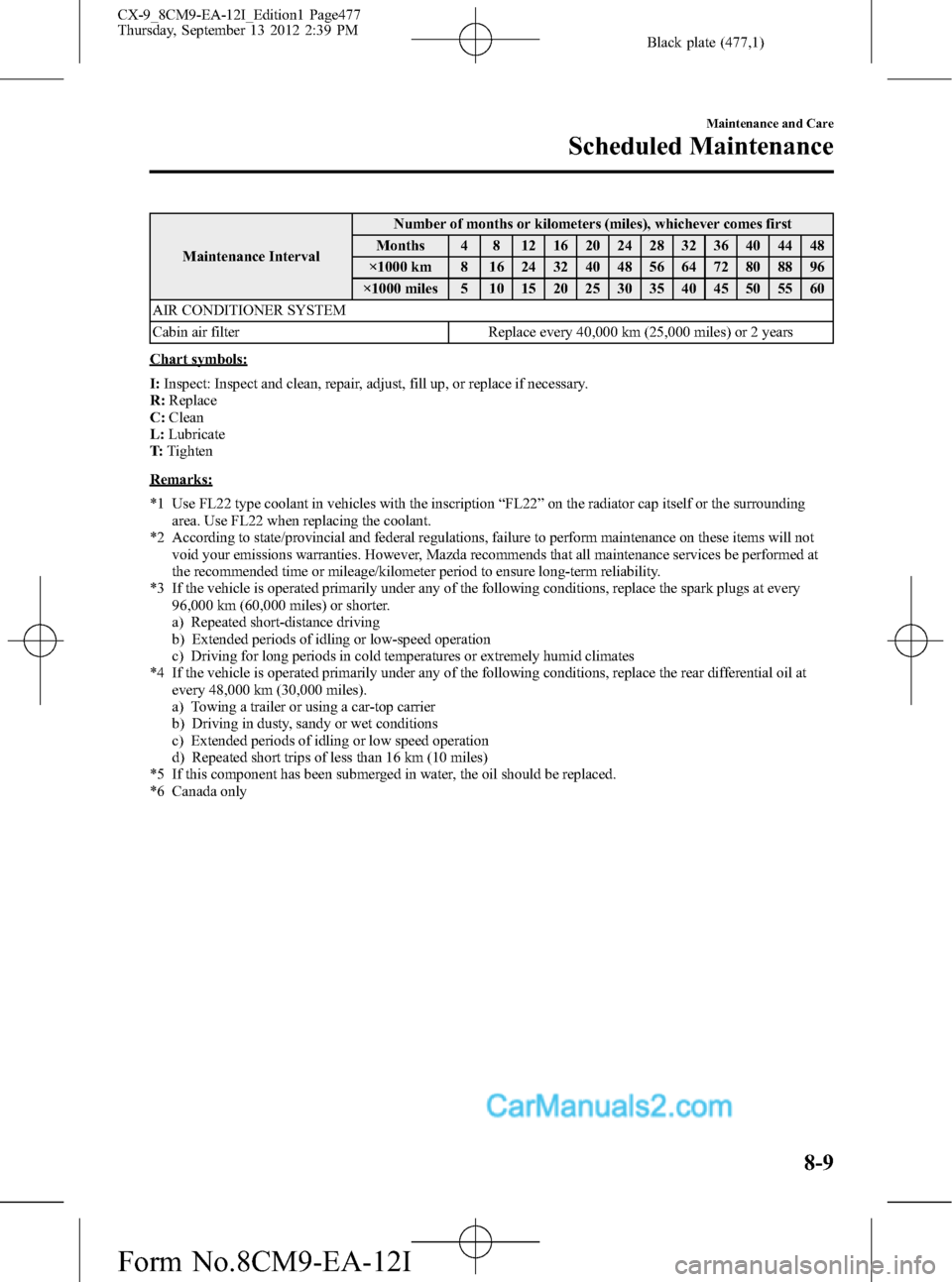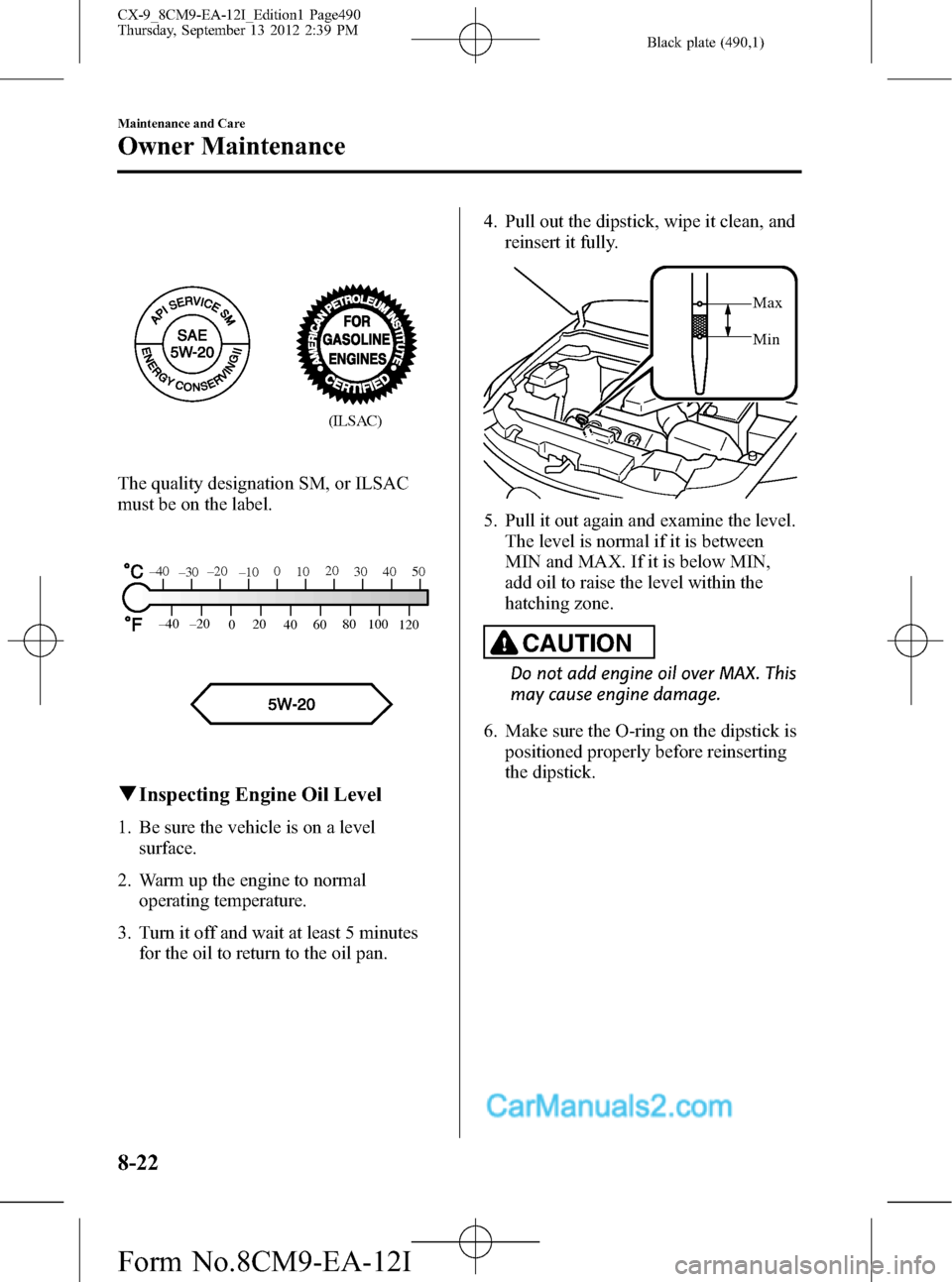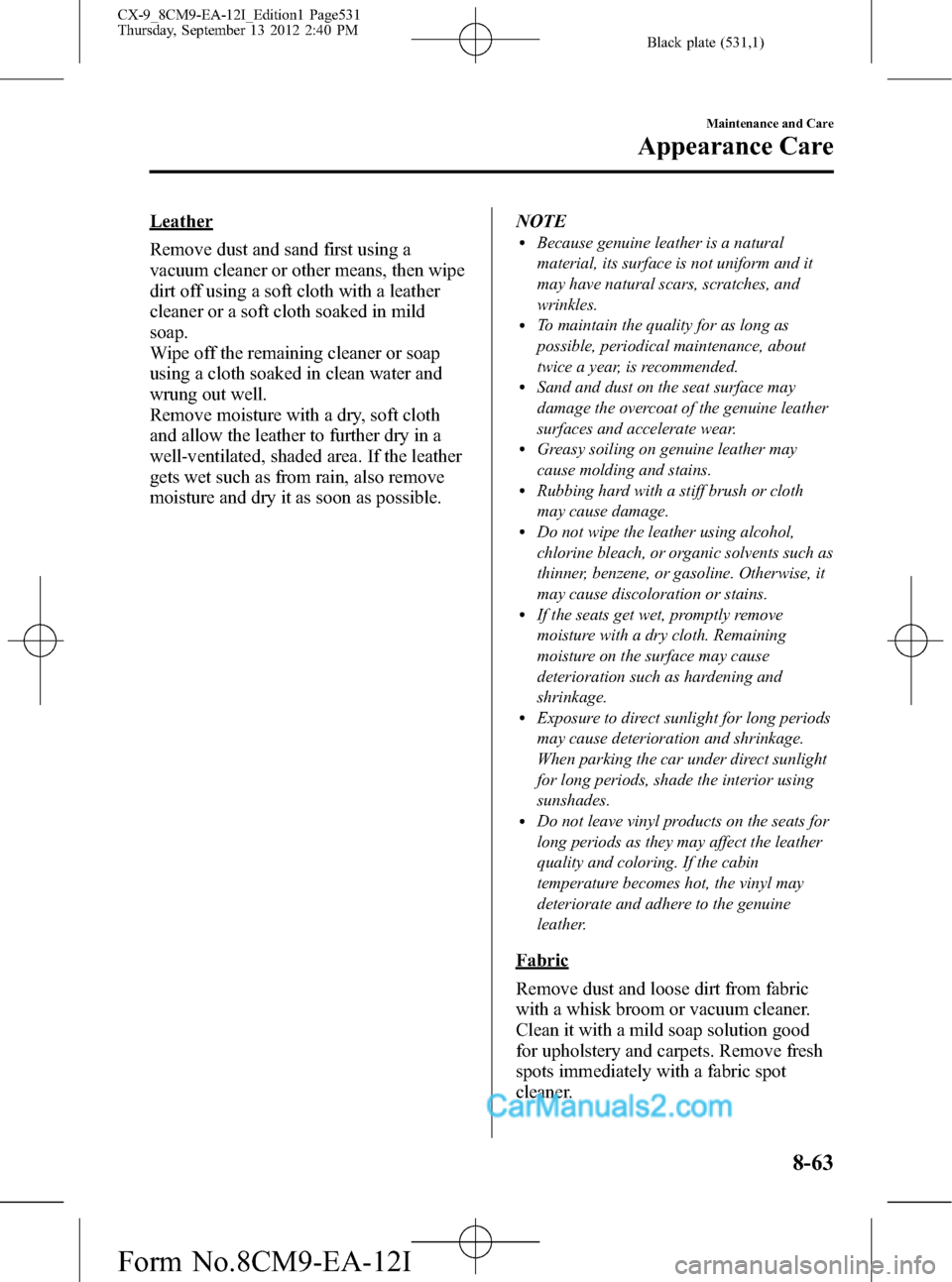oil temperature MAZDA MODEL CX-9 2013 Owners Manual (in English)
[x] Cancel search | Manufacturer: MAZDA, Model Year: 2013, Model line: MODEL CX-9, Model: MAZDA MODEL CX-9 2013Pages: 598
Page 194 of 598

Black plate (194,1)
qAWD Driving
WARNING
Avoid sharp turns, excessive speed and
abrupt maneuvers when driving this
vehicle:
Sharp turns, excessive speed and
abrupt maneuvering of this vehicle is
dangerous as it could result in the
increased risk of loss of vehicle
control, vehicle roll-over, personal
injury or death.
This vehicle has a higher center of
gravity. Vehicles with a higher center
of gravity such as utility and AWD
vehicles handle differently than
vehicles with a lower center of
gravity.
Utility and AWD vehicles are not
designed for cornering at high speeds
any more than low profile sports cars
are designed to perform satisfactorily
under off-road conditions. In
addition, utility vehicles have a
significantly higher rollover rate than
other types of vehicles.
RSC might help if you get into
trouble, but then it might not be able
to allow you to fully recover, always
drive carefully with the vehicle's
height in mind.
Drive carefully when the vehicle is
loaded by lowering vehicle speed and
applying the brakes earlier:
Abrupt maneuvering and sudden
braking when driving a loaded
vehicle is dangerous as the driving
behavior of a vehicle with a high
center of gravity is different when it is
loaded compared to when it is not,
and could result in the loss of vehicle
control and an accident.
qAWD Warning Light
This warning light stays on for a few
seconds when the ignition is switched
ON.
Thereafter, the warning light will
illuminate or flash under the following
conditions:
lIlluminates when there is an
abnormality with the AWD system.
lFlashes when the differential oil
temperature is abnormally high.
lFlashes when there are continually
large differences between front and rear
wheel rotation, such as when trying to
pull away from an icy surface, or when
trying to extricate the vehicle from
mud, sand or similar conditions.
If the AWD warning light illuminates:
If the AWD warning light illuminates,
contact an Authorized Mazda Dealer.
If the AWD warning light flashes:
Park the vehicle in a safe place. After a
few moments, if the warning light stops
flashing, you can resume driving. If the
light does not stop flashing, contact an
Authorized Mazda Dealer.
5-18
Driving Your Mazda
Starting and Driving
CX-9_8CM9-EA-12I_Edition1 Page194
Thursday, September 13 2012 2:36 PM
Form No.8CM9-EA-12I
Page 232 of 598

Black plate (232,1)
CAUTION
If the automatic transaxle warning
light illuminates, the transaxle has
an electrical problem. Continuing to
drive your Mazda in this condition
could cause damage to your
transaxle. Consult an Authorized
Mazda Dealer as soon as possible.
qAWD Warning Light (AWD)
This warning light stays on for a few
seconds when the ignition is switched
ON.
Thereafter, the warning light will
illuminate or flash under the following
conditions:
lIlluminates when there is an
abnormality with the AWD system.
lFlashes when the differential oil
temperature is abnormally high.
lFlashes when there are continually
large differences between front and rear
wheel rotation, such as when trying to
pull away from an icy surface, or when
trying to extricate the vehicle from
mud, sand or similar conditions.
If the AWD warning light illuminates:
If the AWD warning light illuminates,
contact an Authorized Mazda Dealer.
If the AWD warning light flashes:
Park the vehicle in a safe place. After a
few moments, if the warning light stops
flashing, you can resume driving. If the
light does not stop flashing, contact an
Authorized Mazda Dealer.
WARNING
Never spin a wheel that is off the
ground:
Spinning a wheel that is off the
ground as a result of the vehicle
being stuck or in a ditch is
dangerous. The drive assembly could
be seriously damaged which could
lead to an accident or could even
lead to overheating, oil leakage, and
a fire.
qTire Pressure Monitoring System
(TPMS) Warning Lightí
This warning light illuminates for a few
seconds when the ignition is switched
ON.
Thereafter, the warning light illuminates
and a beep is heard when tire pressure is
too low in one or more tires, and flashes
when there is a system malfunction.
5-56
Driving Your Mazda
íSome models.
Warning/Indicator Lights and Beep Sounds
CX-9_8CM9-EA-12I_Edition1 Page232
Thursday, September 13 2012 2:36 PM
Form No.8CM9-EA-12I
Page 477 of 598

Black plate (477,1)
Maintenance IntervalNumber of months or kilometers (miles), whichever comes first
Months 4 8 12 16 20 24 28 32 36 40 44 48
×1000 km 8 16 24 32 40 48 56 64 72 80 88 96
×1000 miles 5 10 15 20 25 30 35 40 45 50 55 60
AIR CONDITIONER SYSTEM
Cabin air filter Replace every 40,000 km (25,000 miles) or 2 years
Chart symbols:
I:Inspect: Inspect and clean, repair, adjust, fill up, or replace if necessary.
R:Replace
C:Clean
L:Lubricate
T:Tighten
Remarks:
*1 Use FL22 type coolant in vehicles with the inscription“FL22”on the radiator cap itself or the surrounding
area. Use FL22 when replacing the coolant.
*2 According to state/provincial and federal regulations, failure to perform maintenance on these items will not
void your emissions warranties. However, Mazda recommends that all maintenance services be performed at
the recommended time or mileage/kilometer period to ensure long-term reliability.
*3 If the vehicle is operated primarily under any of the following conditions, replace the spark plugs at every
96,000 km (60,000 miles) or shorter.
a) Repeated short-distance driving
b) Extended periods of idling or low-speed operation
c) Driving for long periods in cold temperatures or extremely humid climates
*4 If the vehicle is operated primarily under any of the following conditions, replace the rear differential oil at
every 48,000 km (30,000 miles).
a) Towing a trailer or using a car-top carrier
b) Driving in dusty, sandy or wet conditions
c) Extended periods of idling or low speed operation
d) Repeated short trips of less than 16 km (10 miles)
*5 If this component has been submerged in water, the oil should be replaced.
*6 Canada only
Maintenance and Care
Scheduled Maintenance
8-9
CX-9_8CM9-EA-12I_Edition1 Page477
Thursday, September 13 2012 2:39 PM
Form No.8CM9-EA-12I
Page 490 of 598

Black plate (490,1)
(ILSAC)
The quality designation SM, or ILSAC
must be on the label.
80
60
40 20
0 –40 –20
30
120 100
50 40 20
10 0
–10 –20
–30 –40
qInspecting Engine Oil Level
1. Be sure the vehicle is on a level
surface.
2. Warm up the engine to normal
operating temperature.
3. Turn it off and wait at least 5 minutes
for the oil to return to the oil pan.4. Pull out the dipstick, wipe it clean, and
reinsert it fully.
Max
Min
5. Pull it out again and examine the level.
The level is normal if it is between
MIN and MAX. If it is below MIN,
add oil to raise the level within the
hatching zone.
CAUTION
Do not add engine oil over MAX. This
may cause engine damage.
6. Make sure the O-ring on the dipstick is
positioned properly before reinserting
the dipstick.
8-22
Maintenance and Care
Owner Maintenance
CX-9_8CM9-EA-12I_Edition1 Page490
Thursday, September 13 2012 2:39 PM
Form No.8CM9-EA-12I
Page 494 of 598

Black plate (494,1)
Power Steering Fluid
qInspecting Power Steering Fluid
Level
CAUTION
To avoid damage to the power
steering pump, don't operate the
vehicle for long periods when the
power steering fluid level is low.
NOTE
Use specified power steering fluid (page 10-4).
Inspect the fluid level in the reservoir at
each engine oil change with the engine off
and cold. Add fluid if necessary; it does
not require periodic changing.
The level must be kept between MAX and
MIN.
Visually examine the lines and hoses for
leaks and damage.
If new fluid is required frequently, consult
an Authorized Mazda Dealer.
Washer Fluid
qInspecting Washer Fluid Level
WARNING
Use only windshield washer fluid or
plain water in the reservoir:
Using radiator antifreeze as washer
fluid is dangerous. If sprayed on the
windshield, it will dirty the
windshield, affect your visibility, and
could result in an accident.
Using Washer Fluid Without Anti-freeze
Protection in Cold Weather:
Operating your vehicle in
temperatures below 4 degrees C (40
degrees F) using washer fluid without
anti-freeze protection is dangerous
as it could cause impaired windshield
vision and result in an accident. In
cold weather, always use washer
fluid with anti-freeze protection.
NOTE
State or local regulations may restrict the use
of volatile organic compounds (VOCs), which
are commonly used as anti-freeze agents in
washer fluid. A washer fluid with limited VOC
content should be used only if it provides
adequate freeze resistance for all regions and
climates in which the vehicle will be operated.
8-26
Maintenance and Care
Owner Maintenance
CX-9_8CM9-EA-12I_Edition1 Page494
Thursday, September 13 2012 2:39 PM
Form No.8CM9-EA-12I
Page 530 of 598

Black plate (530,1)
lHigh water temperature and high water
pressure car washers are available
depending on the type of high pressure
car washer device. If the car washer
nozzle is put too close to the vehicle or
aimed at one area for an extended
period of time, it could deform plastic
parts or damage the paint.
lDo not use wax containing compounds
(polish). Otherwise, it could result in
paint damage.
lIn addition, do not use an electrical or
air tool to apply wax. Otherwise, the
frictional heat generated could result in
deformation of plastic parts or paint
damage.
Interior Care
WARNING
Do not spray water in the cabin:
Splashing water on electrical parts
such as the audio unit and switches
is dangerous as it could cause a
malfunction or a fire.
qDashboard Precautions
Prevent caustic solutions such as perfume
and cosmetic oils from contacting the
dashboard. They'll damage and discolor
the dashboard. If these solutions get on
the dashboard, wipe them off
immediately.
CAUTION
Do not use glazing agents.
Glazing agents contain ingredients
which may cause discoloration,
wrinkling, cracks and peeling.
qCleaning the Upholstery and
Interior Trim
Vinyl
Remove dust and loose dirt from vinyl
with a whisk broom or vacuum cleaner.
Clean vinyl with a leather-and-vinyl
cleaner.
8-62
Maintenance and Care
Appearance Care
CX-9_8CM9-EA-12I_Edition1 Page530
Thursday, September 13 2012 2:40 PM
Form No.8CM9-EA-12I
Page 531 of 598

Black plate (531,1)
Leather
Remove dust and sand first using a
vacuum cleaner or other means, then wipe
dirt off using a soft cloth with a leather
cleaner or a soft cloth soaked in mild
soap.
Wipe off the remaining cleaner or soap
using a cloth soaked in clean water and
wrung out well.
Remove moisture with a dry, soft cloth
and allow the leather to further dry in a
well-ventilated, shaded area. If the leather
gets wet such as from rain, also remove
moisture and dry it as soon as possible.NOTElBecause genuine leather is a natural
material, its surface is not uniform and it
may have natural scars, scratches, and
wrinkles.
lTo maintain the quality for as long as
possible, periodical maintenance, about
twice a year, is recommended.
lSand and dust on the seat surface may
damage the overcoat of the genuine leather
surfaces and accelerate wear.
lGreasy soiling on genuine leather may
cause molding and stains.
lRubbing hard with a stiff brush or cloth
may cause damage.
lDo not wipe the leather using alcohol,
chlorine bleach, or organic solvents such as
thinner, benzene, or gasoline. Otherwise, it
may cause discoloration or stains.
lIf the seats get wet, promptly remove
moisture with a dry cloth. Remaining
moisture on the surface may cause
deterioration such as hardening and
shrinkage.
lExposure to direct sunlight for long periods
may cause deterioration and shrinkage.
When parking the car under direct sunlight
for long periods, shade the interior using
sunshades.
lDo not leave vinyl products on the seats for
long periods as they may affect the leather
quality and coloring. If the cabin
temperature becomes hot, the vinyl may
deteriorate and adhere to the genuine
leather.
Fabric
Remove dust and loose dirt from fabric
with a whisk broom or vacuum cleaner.
Clean it with a mild soap solution good
for upholstery and carpets. Remove fresh
spots immediately with a fabric spot
cleaner.
Maintenance and Care
Appearance Care
8-63
CX-9_8CM9-EA-12I_Edition1 Page531
Thursday, September 13 2012 2:40 PM
Form No.8CM9-EA-12I
Page 593 of 598

Black plate (593,1)
B
Bulb Replacement ............................. 8-40
C
Capacities .......................................... 10-5
Carbon Monoxide ............................... 4-4
Cargo Securing Loops .................... 6-175
Cargo Sub-Compartment ................ 6-175
Catalytic Converter ............................. 4-3
Cell Phones ....................................... 9-21
Center Console ................................ 6-174
Child Restraint
Child restraint precautions ......... 2-35
Child-restraint system installation
position ...................................... 2-40
Installing child-restraint
systems ....................................... 2-41
LATCH child-restraint
systems ....................................... 2-49
Child Safety Locks for Rear Doors ... 3-32
Climate Control System ...................... 6-2
Gas specifications ...................... 10-5
Clock ............................................... 6-168
Courtesy Lights ............................... 6-166
Cruise Control ................................... 5-20
Cup Holder ...................................... 6-171
Customer Assistance ........................... 9-2
D
Dashboard Illumination .................... 5-48
Daytime Running Lights ................... 5-70
Defroster
Mirror ......................................... 5-79
Rear window .............................. 5-78
Dimensions ....................................... 10-5
Door Locks ....................................... 3-28
Driving In Flooded Area ................... 4-12
D
Driving on Uneven Road .................. 4-13
Driving Tips ........................................ 4-6
Automatic transaxle ................... 5-16
Break-in period ............................ 4-6
Driving in flooded area .............. 4-12
Driving on uneven road ............. 4-13
Hazardous driving ........................ 4-7
Money-saving suggestions ........... 4-6
Rocking the vehicle ...................... 4-9
Winter driving ............................ 4-10
Dynamic Stability Control
(DSC)/Roll Stability Control
(RSC) ................................................ 5-26
TCS/DSC/RSC Indicator light.... 5-27
E
Emergency Starting ........................... 7-18
Jump-starting .............................. 7-18
Push-starting .............................. 7-20
Emergency Towing ........................... 7-21
Emission Control System .................... 4-3
Engine
Coolant ....................................... 8-23
Exhaust gas .................................. 4-4
Hood release .............................. 3-49
Oil .............................................. 8-21
Overheating ................................ 7-16
Starting ......................................... 5-4
Engine Compartment Overview ........ 8-20
Engine Coolant
Overheating ................................ 7-16
Engine Coolant Temperature
Gauge ................................................ 5-47
Event Data Recorder ......................... 9-22
Exhaust Gas ........................................ 4-4
Exterior Care ..................................... 8-58
Index
11-3
CX-9_8CM9-EA-12I_Edition1 Page593
Thursday, September 13 2012 2:40 PM
Form No.8CM9-EA-12I